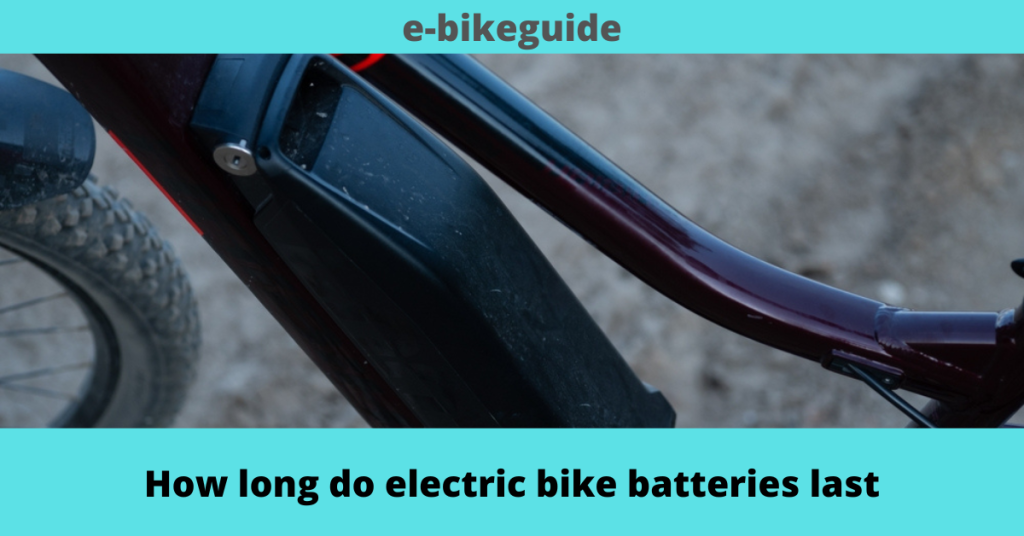
The cost of the battery for your electric bike can be as much as a third of the total cost of the bike, so it’s crucial that you invest in a high-quality battery and maintain it properly. In the case of Pedego Canada, all electric bikes come with a 5 Year Prorated Battery Warranty, making it one of the best in the industry. How long do electric bike batteries last? That’s the question everyone wants to know, and the answer is not always simple. For example, it depends on the type of battery, the weight, and the terrain of the bike. Read the whole story here.

How long do electric bike batteries last? Learn the basics and find out how to buy the best electric bike batteries and what to look for in a battery. We know our batteries are reliable because we use only high-quality cells in them. If you remember nothing else from this article, let it be this: only purchase an electric bike with a minimum 5-year battery warranty, and aim to get a battery made by one of the “big three” name-brand cells (Samsung, Panasonic, or Sony). The quality of construction and warranty on low-priced electric bicycles like those sold at Costco are not sufficient to guarantee that you will have years of reliable use. We suggest investing a little more money initially to avoid the hassle (or worse, the trash) later on.

The battery in any modern electric bike is almost certainly made of lithium. Lithium batteries, which have been around since 1912, have just been popular and cost-effective in consumer applications in the last 15 years. The electrolyte of “lithium-ion” batteries and “lithium polymer” (also known as “lithium-ion polymer”) batteries are the defining characteristic of the two. There isn’t much of a difference outside that, though. Although Li-Polymer offers a modest boost in energy density, it is 10-30% more expensive, leaving manufacturers undecided. Different batteries use various lithium chemistries, with some manufacturers claiming their products are inherently more durable. However, proper maintenance remains the most crucial component in determining a battery’s lifespan. A properly cared-for battery has an expected lifespan of three to five years.
Don’t Let The Battery Get Hot

One of the most significant influences on lithium batteries is their surroundings. If you leave one in your car in the blazing sun, for instance, you will definitely shorten the lifespan of your battery. Actually, that’s the worst-case scenario: storing a fully charged battery under hot conditions. The best way to prolong the life of your bike’s battery is to keep it out of the sun and in a cool environment, ideally below 20 degrees Celsius (68 degrees Fahrenheit). Below is a chart from Battery University illustrating how temperature affects a battery’s usable capacity during a charge. You Should Keep A Discharged Battery In Storage, But Not Too Discharged! Recoverable capacity is affected by storing a fully charged battery, as shown in the following graph. Since a lithium-ion battery can steadily discharge over time even when you’re not using it, storing one that is completely empty can have disastrous consequences.

Depending on how long the voltage is allowed to drop below a particular point, irreversible cell damage may occur. For long-term storage, the battery should ideally be charged to between 80% and 40% of its capacity. To prepare a charger for storage, just switch to its lower storage voltage level. An alternative is to ride the bike after completely charging it and then putting it away. Keeping your battery at or near 100% charge will shorten its lifespan, so avoid leaving it on the charger for extended periods of time. Every couple of months during the winter, you can check on your battery to make sure it’s still working. A quick charge can restore the battery to its optimal storage voltage if you find that its indicator has fallen too low (this is unlikely to be necessary if the battery is at 40% or above).

A half-hour charge every few months is recommended if you don’t have a battery indication. Again, it’s best to avoid storing a fully charged battery (though it’s not the end of the world if it does). Battery life can be extended by avoiding frequent full discharge. It’s shocking that even now, after being shown to be harmful, several tech sites recommend regularly draining your battery to its full capacity. The next chart, again provided by Battery University, demonstrates that it is hazardous to consistently discharge lithium-ion batteries to 0% and that it is recommended to perform partial discharges with routine top-ups to increase the recharge-cycle lifespan of the batteries. No need to worry if you need to empty your bladder completely once in a while on that really long trip.

How long do electric bike batteries last? Here’s everything you need to know about electric bike batteries and how they work. Lithium batteries do not have the memory effect’ that other battery chemistries do. Thus it is fine to top them off often, and, as the chart below indicates, it is better to run them in the top half of their discharge cycle. It is preferable to charge it every few rides rather than every ride if you are performing many short rides (to avoid long durations at or close to 100% charge, as described above). For the winter months, keep in mind that charging your battery should be done at a temperature above freezing to avoid damaging the cells. You can ride the bike at temperatures below freezing without worrying about the battery, but you should let it warm up first. You might anticipate a decrease in power and range when riding in really cold weather. Keeping the battery inside when you’re not using it can help prevent this from happening.

Doing so will give you that extra kick! If you follow the steps outlined above, your battery should last you for many more years. Carefully maintaining a lithium battery will extend its life by three to five years, while neglecting to do so can severely harm it in as little as one season. The aforementioned charts were culled from the fantastic online site Battery University, where you can find much more in-depth, scientific information on batteries and how to care for them. The batteries in electric bikes are highly efficient and may be used for a long time. They can cover great distances without stopping for fuel most of the time. The battery life might range from one hour to several days. Depending on size and usage, a typical electric bike battery will last anywhere from 12 hours to 3 days.

Longer rides necessitate either bringing a fully charged spare battery or charging the one you’re using as soon as possible. Many batteries can go through between a thousand and two thousand charges. Consumers often fail to see the significance of battery technology. This is because power storage has become increasingly important in recent years, with electric bikes serving as a prime example of this trend. The lithium battery found in most electric bike packs is one of the most efficient battery types on the market. Because electric bikes need to be portable and able to travel far on a single charge, this technology is ideal for them. As more and more individuals choose electric bikes as their major mode of transportation, manufacturers are scrambling to create safe, durable, and long-lasting electric bike components. Long-lasting batteries that can power their devices for several hours without plugging in or being charged.

You can easily locate an electric bike that meets your requirements thanks to the abundance of models now on the market. When do you need to replace the batteries in an electric bike? Electric bike batteries have varying lifespans depending on their usage and construction. In biology, lithium-ion batteries can be charged between 500 and 800 times. However, lithium polymer batteries can withstand between 1000 and 2000 charges before failing. Using public transportation or ride-sharing apps like Uber and Lyft, commuters can save money on gas and parking by riding an electric bike. And because they’re able to replace polluting gas-powered vehicles for daily commute needs, which also saves money and resources as well as protects human health from environmental harm.
How Far Can Electric Bike Go? Are They Worth it?

How long do electric bike batteries last? How to charge electric bike batteries, what to do with dead electric bike batteries and how to recycle electric bike batteries. A major advantage of electric bicycles is that riders can travel further with the same amount of effort. In any case, how can you tell the real range of an e-bike when different manufacturers give vastly varied range ratings for otherwise identical models? It’s much less difficult than you may imagine. I’ve spent over a decade in the electric bicycle sector, and I think I’ve gotten very excellent at what I do. Here are some of the things I’ve learned about e-bike range testing that can help you. To begin, it’s important to note that the range ratings for e-bikes can be altered by a variety of factors, which helps explain why they seem to be so inconsistent. The effective range of an e-bike on a single charge is affected by many factors, including speed, rider weight, terrain type, wind conditions, and tire choice.

The availability of a hand throttle is a further important consideration. Because e-bikes with throttles are uncommon in EU countries, this isn’t something that most riders will have to think about. However, in the United States and other countries where riders are permitted to use hand throttles in addition to pedal assist, the use of a hand throttle can quickly deplete battery life and restrict riding range. How to estimate e-bike range The battery capacity of an electric bicycle is the first factor to consider when estimating the range of an electric bicycle. Watt hours are the standard unit of measurement (Wh). A battery’s voltage and capacity are sometimes listed together; for example, a 48V 10Ah battery powers some electric bicycles. Multiple the voltages by the amp hours to get the Wh equivalent. In other words, the power output of a 48V, 10Ah battery is 480 Wh.

The next step is to divide the battery’s watt-hour capacity by an average efficiency number expressed in miles per watt-hour (or kilometers per watt-hour). Since efficiency statistics will differ depending on the criteria mentioned at the outset of this post, here is the point of the calculations when things become a little hazy. But generally speaking, I get about 25 Wh/mi (or 15.6 Wh/km) on most 500-750W throttle e-bikes while riding at an average speed of 20 mph (32 km/h) on only slightly steep terrain. If the battery capacity of this type of e-bike was 480Wh, then I could travel around 19.2 miles on a single charge (480 Wh divided by 25 Wh/mi). Using a pedal assist is the most productive option. The most pedal assists e-bikes will bring you roughly 15 Wh/mi (or 9.4 Wh/km) if you ride them between 15 and 18 mph on medium pedal assist.

Using the same 480Wh battery on a pedal-assist e-bike would give me a range of about 32 miles (480 Wh 15 Wh/mi = 32 miles). The same equations can be used for estimating a battery’s practical range regardless of its size. On the other hand, as I will demonstrate, the figures can be modified to suit your requirements. You can change the values to suit your needs; I myself weigh about 155 lbs (70 kg). Throttle bikes, for which you may need a figure closer to 30 Wh/mi if you’re a larger guy. You might get closer to 20 Wh/mi if you’re a small, slender thing. For whatever reason, my wife, who is 45 lb (20 kg) lighter than I am, constantly has a greater range than I do. In order to maintain speed and momentum, as well as climb hills, a heavier cyclist will need to exert more effort.
conclusion

How long do electric bike batteries last? Here’s our guide for choosing the right battery for your electric bike. All throughout the world, people are opting for the convenience of electric bicycles as their primary form of transportation. It’s not hard to see why, what with the positive effects on the environment, the savings over automobile ownership, and the versatility offered by the combination of pleasure and practicality. People looking to buy an electric bike often want to know how far they can ride before needing to recharge. Depending on the model, a single charge for a mid-range electric bike can provide you with 45-75 kilometers.

Manufacturers of electric bicycles often exaggerate their products’ purported maximum range. These estimates are unrealistic because they don’t take into account how bikes are really utilized. Even if other elements must be taken into account, the size and power of the motor are the most important when estimating a bike’s range. The worst-case scenario for using an electric bicycle is the same whether you intend to ride it to work during the week or for recreational purposes on the weekends.
